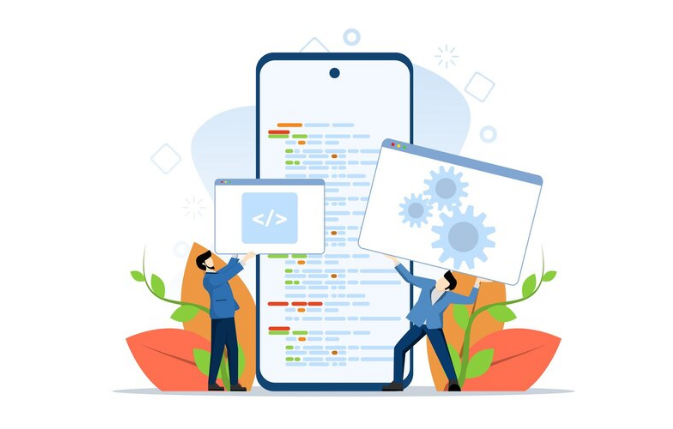Making Every Tap Count: Optimizing the User Interface for Seamless Interaction
 Syed Zohaib Akhter
Syed Zohaib Akhter
The design of an interface, in the ever-evolving world of digital interaction, is about creating a continuous user experience. So, "Making Every Tap Count" isn't just a catchy phrase; it's the design philosophy that's going to take your app to the next level from good. Think of this blog as an exploration into eight best practices in optimizing user interfaces during the mobile app development process for every interaction, making them intuitive, effective, and satisfying. Be you designing a mobile or a desktop interface, these are the principles that will guide you in creating the very interfaces users love to interact with during mobile app development.
8 Best Practices For Optimizing User Interface
The following are the best practices for designing and optimizing the app's UI during mobile app development:
1. Make UI Design That Goes Along With All Audiences:
Try to create a universally appealing design in order to raise user interest. Consider different demographics in modeling an interface, from age and cultural background to tech-savviness. Use intuitive layouts, straightforward typography, and icons that are easy to recognize. Use accessible color schemes and provide good contrast to make it easy for colorblind people to read. Use responsive design to ensure an interface is a good fit for all devices and screen sizes. Do quite a lot of user testing with an extensive user group to gain feedback on how the interface could be perfected. Putting inclusivity in your top priorities, you create a user interface that is more relatable to many users, driving higher levels of satisfaction and broadening your product's reach.
2. Place One Action Per Screen:
Simplifying user interactions by focusing on a single action per screen reduces cognitive load and improves user experience. This approach minimizes confusion and decision fatigue, allowing users to complete tasks more efficiently. Design each screen with a clear purpose and prominent call-to-action. Use visual hierarchy to guide users' attention to the primary action. Provide necessary context and information to support the action without cluttering the interface. If additional options are required, consider using progressive disclosure techniques to reveal them gradually. This streamlined approach enhances user confidence, reduces errors, and increases task completion rates.
3. Create Clear & Big Tappable Buttons:
Designing easily tappable buttons is essential for mobile interfaces. Aim for a minimum touch target size of 44x44 pixels to accommodate various finger sizes. Use ample whitespace around buttons to prevent accidental taps. Implement visual feedback, such as color changes or subtle animations, to confirm user interactions. Choose contrasting colors for buttons to make them stand out from the background. Use clear, concise labels that describe the button's action. Consider using icons alongside text for improved comprehension. Prioritize the most important actions by making them more prominent. Consistently sized and styled buttons across your interface will create a cohesive and user-friendly experience.
4. Create A Clean, Plain And Simple Design:
Embracing simplicity in user interface design enhances usability and aesthetic appeal. Focus on essential elements and remove unnecessary clutter. Use a consistent and limited color palette to create visual harmony. Implement a clear visual hierarchy to guide users through the interface. Utilize negative space effectively to improve readability and focus. Choose clean, legible typography and maintain consistent font styles throughout the app. Group related elements together and use alignment to create a sense of order. Avoid overusing decorative elements that don't serve a functional purpose. A clean, minimalist design reduces cognitive load and allows users to navigate and interact with ease.
5. Minimize Required Data Input:
Reducing the amount of data input required from users streamlines interactions and improves overall satisfaction. Implement smart defaults and auto-fill options whenever possible. Use progressive profiling to gather information gradually over time instead of all at once. Provide alternative input methods like voice recognition or QR code scanning where appropriate. Utilize dropdown menus or radio buttons for predefined options to minimize typing. Implement real-time validation to catch errors early and provide helpful feedback. Consider using location services to automatically populate relevant information. By minimizing data input, you reduce user frustration and increase the likelihood of task completion.
6. Add Dark Mode For Night Usage:
Incorporating a dark mode option enhances user comfort during low-light conditions and conserves device battery life. Design a cohesive dark theme that maintains your app's visual identity. Ensure sufficient contrast between text and background colors for readability. Use darker shades of your primary color palette to maintain brand consistency. Implement smooth transitions between light and dark modes to prevent jarring visual changes. Consider using slightly desaturated colors in dark mode to reduce eye strain. Allow users to manually toggle between modes or sync with system-wide settings. Test your dark mode thoroughly to ensure all UI elements remain visible and functional.
7. Make A User-Friendly Tab Bar:
A well-designed tab bar improves navigation and provides quick access to key features. Limit the number of tabs to 3-5 to prevent overcrowding. Use recognizable icons alongside labels for better comprehension. Implement visual feedback to indicate the active tab. Consider using a floating action button for the most important action if appropriate. Ensure the tab bar remains visible and accessible across all screens for consistency. Use subtle animations to enhance the user experience when switching between tabs. If more options are needed, consider using a "More" tab with additional menu items. A user-friendly tab bar enhances app navigation and improves overall usability.
8. Follow The Platform Aesthetics and Standards:
Adhering to platform-specific design guidelines ensures a familiar and cohesive user experience. Study and implement the Human Interface Guidelines for iOS or Material Design for Android. Use native UI components and interaction patterns whenever possible. Follow platform-specific conventions for navigation, such as the back button placement. Implement appropriate gestures and animations that users expect on each platform. Respect system-wide settings like font sizes and color schemes. Ensure your app's icon adheres to platform guidelines for a polished look. By following platform aesthetics and standards, you create an app that feels natural and intuitive to users, reducing the learning curve and improving adoption.
Conclusion:
User interface optimization is a never-ending process, an activity filled with details, empathizing with the user, and recommissioning to betterment. These eight best practices will lead you in creating interfaces that don't look beautiful only but consequently work in a friendly way. After all, friction must be rubbed away within every tap for the most significant overall experience. Let the design standards evolve with new technologies, relate to them, be elastic, and still keep the needs of the users at the forefront. These principles make it easy for one to create an interface during mobile app development that will be effective in the competitive digital world of today.
Subscribe to my newsletter
Read articles from Syed Zohaib Akhter directly inside your inbox. Subscribe to the newsletter, and don't miss out.
Written by

Syed Zohaib Akhter
Syed Zohaib Akhter
A highly skilled software developer with a strong foundation in designing, developing, and maintaining software applications. Proficient in multiple programming languages and frameworks, including Java, Python, and JavaScript. Experienced in utilizing industry best practices and coding standards to deliver high-quality code. Collaborative team player with excellent problem-solving and communication skills, able to work effectively in cross-functional teams. Passionate about continuous learning and staying up-to-date with the latest technologies and trends in software development.